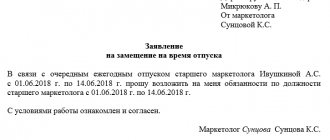Home / Labor Law / Vacation
Back
Published: June 20, 2016
Reading time: 8 min
0
5149
When an employee goes on vacation, his duties are performed by his deputy.
If such a staff position is not provided, and the work must continue, the functions of the vacationer can be transferred to another employee.
- Legislation
- Combination Additional payment
- Decor
- Payment
What is substitution?
Substitution is the assignment of the functions of a temporarily absent employee to another person. Moreover, such a replacement will be a combination if the work is performed by another employee of the enterprise while maintaining the previous position. Sometimes functions are assigned to a person who has just been hired for exactly this position. This affects how it will be:
- registration of replacement;
- payment is made.
The employer, in order not to violate the rights of the employed employee, must be guided by labor legislation.
When is the replacement processed?
It is not always possible to predict the replacement of an employee. If the time of going on vacation or maternity leave is at least approximately known in advance, then it is impossible to guess when a person will go on sick leave or recover. Most often, a replacement is issued if the main employee:
- got sick;
- went on vacation (including maternity leave);
- cannot temporarily work due to other circumstances (in the event of the death of a loved one, for example).
How much time the employer has to find a person who will be assigned the responsibilities of a temporarily absent employee depends on the prevailing circumstances. There are only two options here: arrange for a combination/replacement of one of the existing employees, or hire a new one under a fixed-term contract. When time is short, they usually choose the first option, and for long-term replacement (during maternity leave) they can hire a new employee.
Substitution by another employee
Most often, employers are faced with the need for a replacement suddenly, which greatly shortens the time to find a replacement. Therefore, they prefer to transfer the functions of the absent employee to another employee. This is permitted subject to the rules outlined in Art. 72.2 Labor Code of the Russian Federation.
Unfortunately, many employers shift some of the responsibility of absent employees to current employees without paying extra for it. This practice violates workers' rights. If someone else's job responsibilities have been imposed on you, remind the employer that he must pay extra for this. Moreover, in most cases, in order to transfer these powers, the employer must obtain consent from the employee who will be assigned these functions.
A conscientious employer must make the replacement in full compliance with the law . He must comply with the following rules:
- replacement by another employee of the enterprise is possible, but with an increase in the final salary (if part-time);
- the deputy may be charged with duties other than his position;
- the appointment of an employee to the role of a substitute is possible only with his written consent (except for the cases prescribed in paragraph 2 of Article 72.2 of the Labor Code of the Russian Federation);
- when registering a replacement, an additional agreement is drawn up if information about the replacement is not specified in the employment contract;
- there is a maximum duration of substitution (in emergency situations and without the consent of the employee - 1 year, in other cases these rules are prescribed in the internal regulatory documents of the organization).
All these rules indicate the rights and obligations of each party in the event of replacing one employee with another.
Is it possible to refuse a substitution?
An employer can place a person in another position during the absence of the main employee only after receiving written consent to do so from the replacement. However, there are exceptions to this rule. So, in para. 2 tbsp. 72.2 of the Labor Code of the Russian Federation states in what situations a person can be temporarily transferred to another job even if he refuses. This applies to the following situations:
- natural and man-made disasters;
- accidents that occurred at work;
- accidents that occurred during work;
- fires and fires;
- earthquakes;
- floods;
- strikes and hunger strikes;
- epidemics, as well as mass animal diseases;
- other situations in which there is a direct threat to the life of the population or its normal existence.
If any of this happens, the employer has the right to appoint another employee to the position. However, the duration of such a transfer cannot be more than 1 month. Moreover, the absence of indications of these duties in the employment contract does not exempt a person from fulfilling them.
When the absence of an employee has nothing to do with the listed circumstances, the employer has to negotiate with another worker so that he takes on additional responsibilities. Without this, it makes no sense to draw up orders and other internal documents. Moreover, coercion may entail administrative liability for the employer.
Registration procedure
So, the employee agreed to temporarily perform the duties of an absent employee. What should you do in this case? How to register a replacement for a temporarily absent employee? Step by step it will look like this:
- Obtaining written consent from the employee . The legislation does not establish a uniform form, so it is enough to write it on the organization’s letterhead and express your readiness to fulfill the duties of the absent employee. The document must reflect: information about the parties (employee and employer), the reason for the replacement and its duration, the position to which the employee is transferring (or holding a combined position). Next, the application is signed and the originator’s signature is affixed. If the replacement is related to emergency situations, this item is skipped.
- Drawing up an additional agreement . Its registration is necessary, since the main employment contract does not stipulate the terms of replacement. The additional agreement specifies what position the employee will hold and what functions are assigned to him. The terms of payment and the duration of such replacement must be specified here.
- Making a replacement order . It is imperative to specify in it who is replacing whom and for what reasons. The form of the order itself is no different from the one that is usually issued. It is possible to use the T-5 or T-5a form. After drawing up and signing the order, you need to familiarize the employee (if he agrees, he puts his signature). The document also specifies the terms of payment (tariff rate, salary or other forms of remuneration).
Download an application to replace a temporarily absent employee (sample)
replacement order
It is noteworthy that sometimes an employee is not transferred to the position of an absent employee, but is assigned an internal part-time job. It turns out that he simultaneously performs the duties of his own and temporarily assigned positions. Then all the nuances of the relationship are established on the basis of Art. 60.2 Labor Code of the Russian Federation. The registration itself occurs somewhat differently, since the person does not vacate his main position.
Termination of employment in a temporary position does not require the consent of the replacement, since such an appointment is temporary. At the end of the predetermined period, he returns to perform exclusively his duties, and the absent employee returns to his position.
If suddenly the main employee during his absence decides to quit completely, then the employer in his place can leave a temporary one performing duties (upon receiving his consent) or find a new employee. If the employee agrees, the additional agreement becomes invalid, and a new employment contract is concluded with him. It is usually assumed that such a person vacates his previous position. People most often react positively to such an offer; if the salary is higher, there are prospects for future growth.
Transfer order
We are accustomed to writing a statement for every change. We hasten to please you: an application for replacement during vacation and its sample are not needed .
The transfer order is also not a mandatory document. Its registration is not provided for by law. However, many people do it, which is not a violation. If the company provides for making such an order, you can do it using the form established by the internal document flow.
If the deputy is a new employee
Sometimes an employer decides to hire another person to replace a temporarily absent employee. In this case, registration is carried out in the same way as with a regular hire, but with one caveat - the employment contract is fixed-term, i.e. it is concluded for a certain period of time. The features of its preparation are indicated in Art. 59 Labor Code of the Russian Federation.
When selecting an applicant, it is better for the manager to immediately indicate that the employment will be temporary. After all, not everyone agrees to come to a new organization for a month. In general, this format of labor relations is more logical to use in case of temporary absence of the main employee due to maternity leave.
Going to work while on sick leave
» » » » The question of whether it is allowed to go to work during sick leave and whether such actions are legal is relevant for each of the parties to the labor relationship - this topic is equally of interest to both employers and ordinary workers.
In addition, the greatest number of controversial issues arise when considering how payment is made for work on sick leave. Therefore, both employees and employers should carefully familiarize themselves with all the features of the legal regulation of labor relations in such a situation. Contents: Russian legislation provides workers with a number of social guarantees, which include compensation for periods - after all, from the salary of each employee, contributions are made to the Social Insurance Fund for these purposes.
Salaries calculated arbitrarily by an accountant are not subject to insurance contributions. If the chief accountant regularly transferred to himself a salary in a larger amount than agreed upon in the employment contract, the amounts of such excess are not included in the contribution base.
At the same time, the issue of sick leave is regulated quite strictly - legal regulation in this case is provided by the provisions of both the Labor Code of the Russian Federation and other regulatory documents and, in general, it is influenced by the following legislative acts: Article 183 of the Labor Code of the Russian Federation.
Electronic demands for payment of taxes and contributions: new rules for referral Recently, tax authorities updated forms for requests for payment of debts to the budget, incl.
on insurance premiums. Now it’s time to adjust the procedure for sending such requirements through the TKS. It is not necessary to print payslips. Employers do not have to issue payslips on paper to employees. The Ministry of Labor does not prohibit sending them to employees by email. “Physicist” transferred payment for the goods by bank transfer - you need to issue a check In the case when an individual transferred payment for the goods to the seller (company or individual entrepreneur) by bank transfer through a bank, the seller is obliged to send a cashier’s check to the “physicist” buyer, the Ministry of Finance believes.
Payment Features
One of the most important issues is how to pay for replacing a temporarily absent employee. It is important to take into account the circumstances that gave rise to the current situation.
If a person is transferred to another position due to emergency circumstances, then the minimum amount of work is determined in accordance with paragraph. 4 tbsp. 72.2 Labor Code of the Russian Federation. Such an employee in a new place must receive no less than his usual salary. The parties can agree to increase this amount, for example, based on work results.
When no emergency situations preceded the replacement, and the employee agreed to temporarily take another position, the amount of his remuneration is discussed and calculated individually. The specifics of such agreements are reflected in the additional agreement.
Typically the final size is influenced by:
- complexity and amount of work in a temporary position;
- qualification level;
- working conditions.
In fact, the salary may be higher or lower than the main position. In case of combination, we are talking about additional payments.
An example of an additional agreement
To make it clear, let’s look at an example of concluding an additional agreement on transfer.
EXAMPLE
Let’s assume that at JSC “Store No. 1” the senior manager Sokolov L.I. transferred to the position of head of the trading department A.P. Kravchenko.
This is the wording that would be in the additional agreement:
“JSC “Magazin No. 1”, hereinafter referred to as “Employer”, represented by the Chairman of the Board Igor Vasilievich Savchenko, acting on the basis of the minutes of the board No. 18 dated October 15, 2018, on the one hand, and Lyudmila Ivanovna Sokolova, hereinafter referred to as “ Employee”, on the other hand, collectively referred to as the “Parties”, have entered into this Additional Agreement (hereinafter referred to as the Agreement) as follows:
In connection with the annual paid leave of the head of the trade department, Aleftina Pavlovna Kravchenko, the Employee is temporarily transferred to the position of head of the trade department.
Start and end of temporary transfer: from 10/01/2020 to 10/28/2020 inclusive.
During the specified period, the Employee performs duties in accordance with the job description of the head of the sales department.
For the period of performance of official duties as the head of the trading department, the Employee is given a salary of 50,000 (Fifty thousand) rubles 00 kopecks.
The remaining terms of the employment contract No. 434-K dated August 15, 2017 remain unchanged.
The agreement is an integral part of the employment contract dated August 15, 2017 No. 434-K.
The agreement is drawn up and signed in two copies having equal legal force, one of which is kept by the Employer, the other is transferred to the Employee.”









